What Are Furcations?
Branching Tooth Roots Can Be Periodontal Nightmares
Dear Doctor,
My periodontist says I have “furcation involvements,” which are difficult to treat. What does this mean?
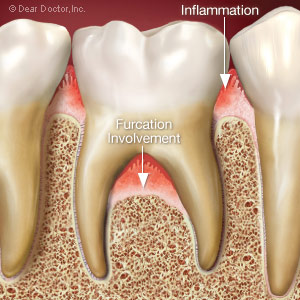 |
| An illustration showing gum disease causing bone loss in the furcation of a lower molar. |
Dear Sylvia,
Most people haven't heard of furcations when it comes to teeth or dentistry, but may be familiar with the word “bifurcate” — to fork or separate — and that's exactly how it applies to teeth. A furcation is the place where the roots of teeth fork or separate, taking different paths from one another.
Furcation Involvement
A furcation involvement, also called a furcation invasion, is defined as an area of bone loss at this branching point of a tooth root. The bone loss results from periodontal (gum) disease.
The periodontal structures (“peri” – around; “odont” – tooth) comprise the unique way in which teeth are attached to the bone that supports and surrounds them in health, and get detached, unfortunately, in disease.
Almost all forms of periodontal diseases are caused by the accumulations of bacterial biofilm (plaque). Therefore, the essential treatment is to keep the teeth free of these harmful bacteria and their related products, calculus and tartar, which accumulate on the root surfaces. Herein lies the problem: It is one thing for an individual to remove superficial bacterial biofim above the gum line by brushing and flossing — the patient's main responsibility in maintaining periodontal health. It is quite another to clean hard-to-reach areas where the periodontal tissues have become detached from the tooth beneath the gum line — the clinician's responsibility. It is especially difficult to clean furcation areas. It's like trying to clean out a cave through a narrow entrance and, only from the outside looking in.
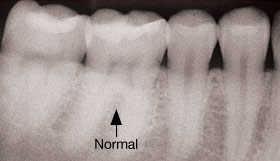 |
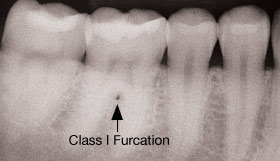 |
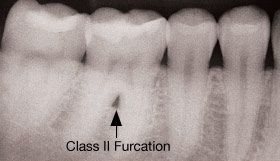 |
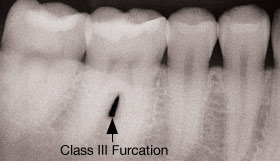 |
Assessing The Problem
The first step is to identify the presence and extent of furcation involvements, and their specific anatomy (or shape). Specially curved probes are used to seek out, and by gentle probing, examine the contours of furcations exposed by bone loss. The clinician has to probe vertically beneath detached gum (like rappelling down the outside of a cave) and then feel for a furcation invasion by exploring horizontally to see how far bone loss has extended (like entering into the cave to explore its inner size and shape).
A typical classification of furcation invasions is:
- Class I — Early. The furcation can be felt as a groove, but there is not yet bone loss.
- Class II — Moderate. The furcation can be probed two or more millimeters horizontally, so there is definitely bone loss.
- Class III — Advanced or “Through and Through.” Bone loss extends from one side of the affected root all the way through to the other.
Radiographs (x-ray pictures), along with tactile exploration (perception by touch) and a good deal of experience are required to detect and confirm a furcation invasion.
The Treatment Challenge
You should be getting an inkling of why furcation involvements pose such a treatment challenge. Access is compromised because furcation involvement usually is sub-gingival (“sub” – under; “gingival” – gum). Therefore treatment is indeed challenging. Furcations may be very difficult to clean and maintain.
Specially shaped scalers or curettes are the instruments used to clean root surfaces affected by periodontal disease. Ultrasonic scalers, which use high-frequency vibrations and streaming water to loosen and flush debris and biofilm, play a critical role in treatment. Topically or locally applied antimicrobials and antibiotics have also proven helpful as part of a routine maintenance regime in trying to disinfect and stabilize the furcations, but their effectiveness may be limited.
Periodontal therapy may also include surgical treatment for furcation invasions with two basic goals: to regrow periodontal tissues, including bone, in the furcation areas; and/or to make the areas more accessible for cleaning — both by you, the patient, and your dental hygienist.
The more involved the furcation, the more difficult it is to regenerate and maintain healthy tissue.
As always, the more involved the furcation (i.e., the more bone lost), the more difficult it is to regenerate and maintain healthy tissue. The decision to perform surgery to improve periodontal prognosis (outlook) for furcations will depend upon the knowledge, understanding and experience of the periodontal surgeon — and a discussion with you, the patient.
Dental Hygienists To The Rescue!
The long-term outlook, or prognosis, for teeth with furcation invasions is improved by careful treatment and frequent maintenance, especially in the hands of an experienced hygienist working with a periodontist, or a dentist trained in the management of advanced periodontal disease. Caring for furcation invasions requires particular understanding of root anatomy, tactile sense, and experience. It usually falls to the dental hygienist to maintain these difficult and challenging areas on a routine basis, and to keep affected teeth healthy for as long as they will last.




